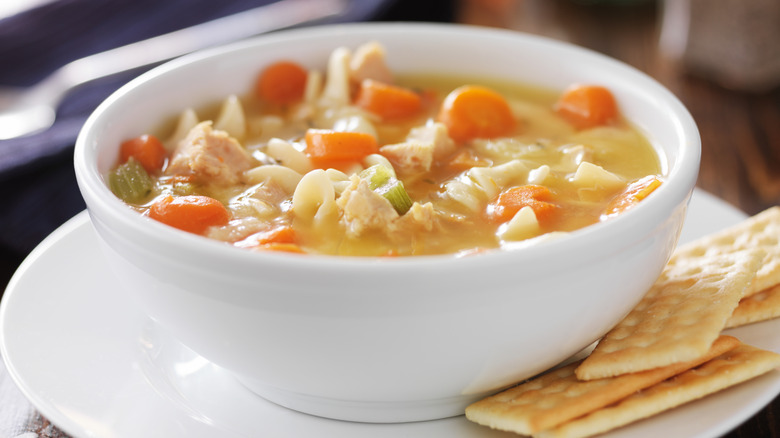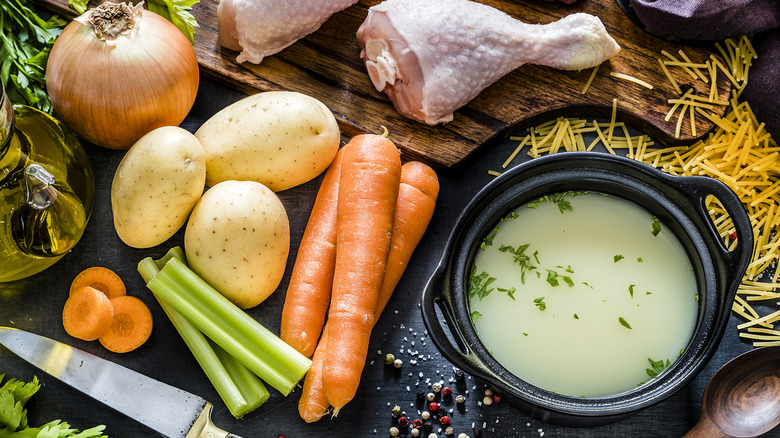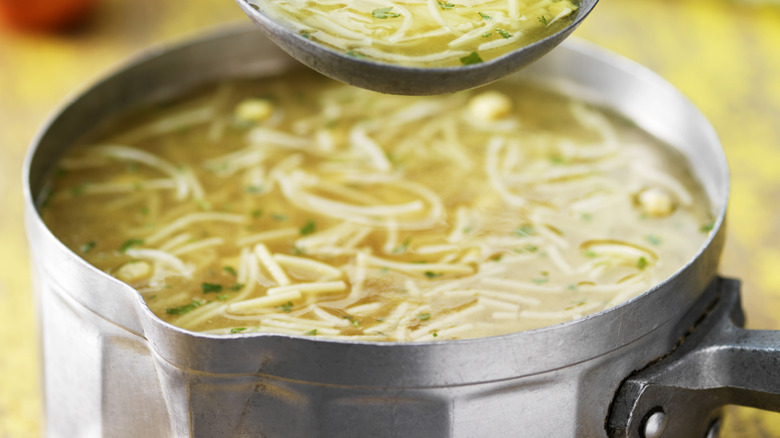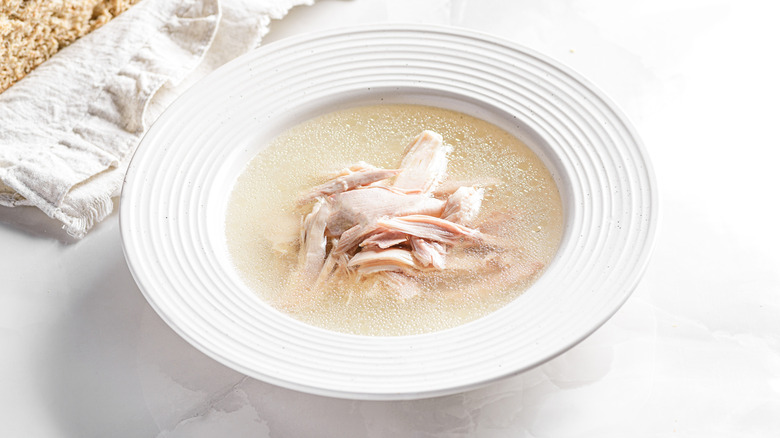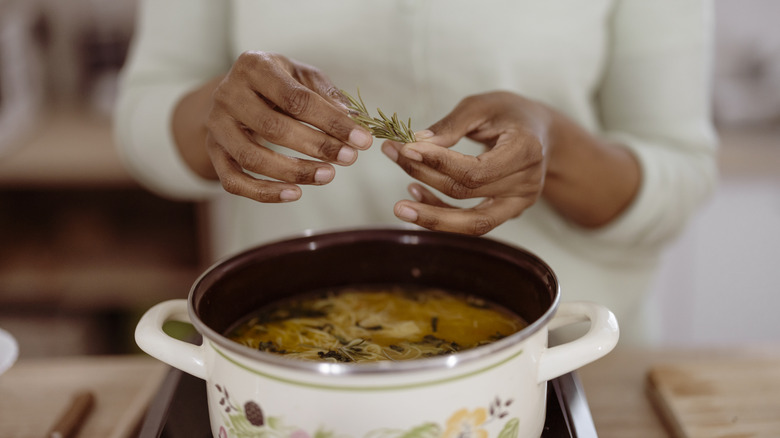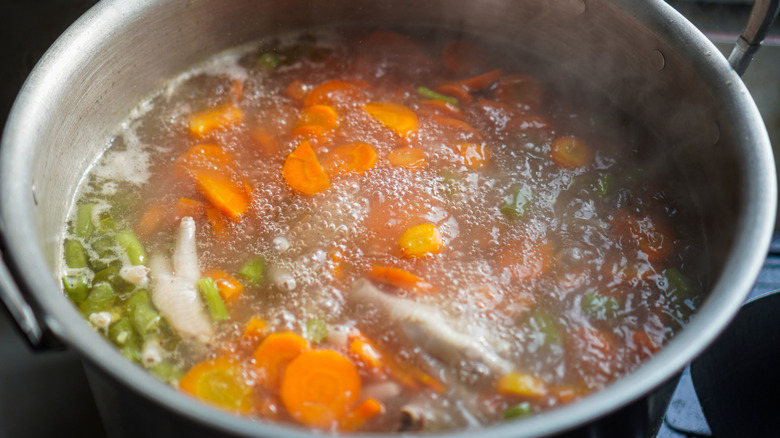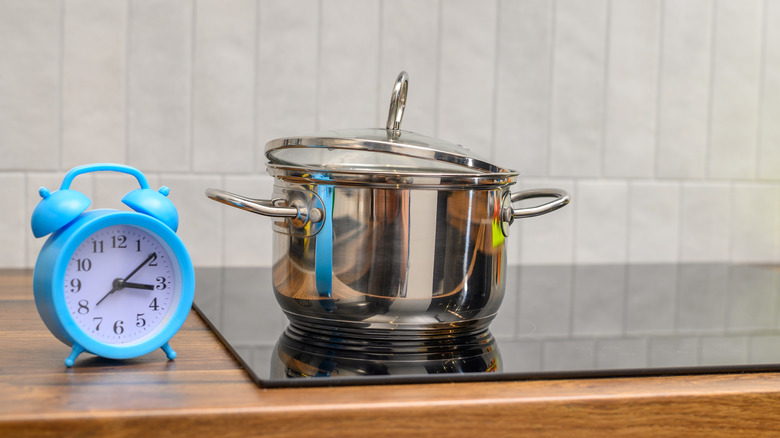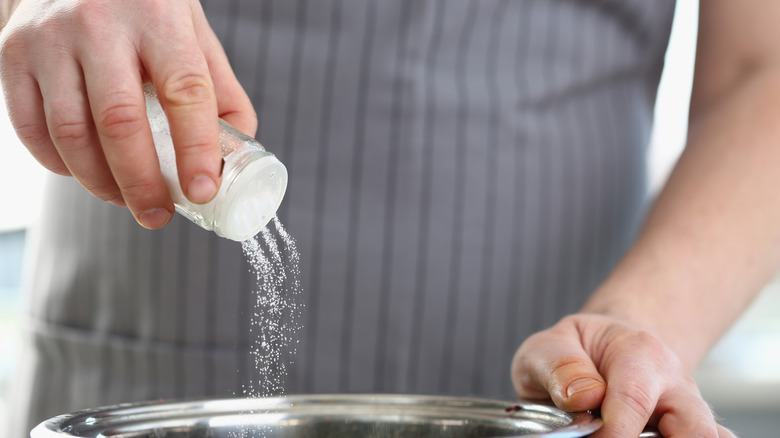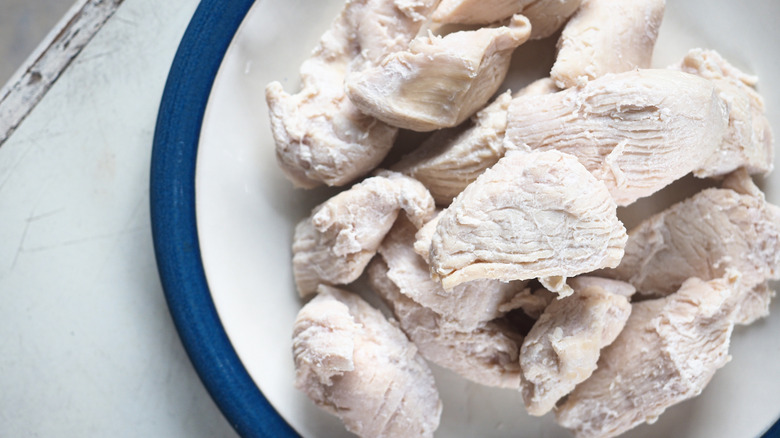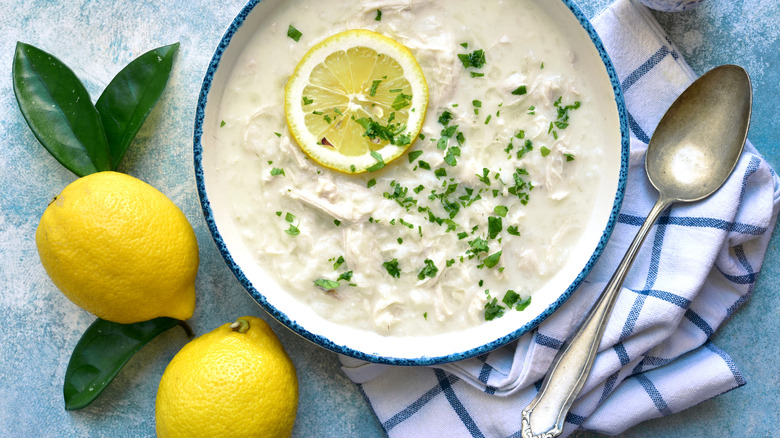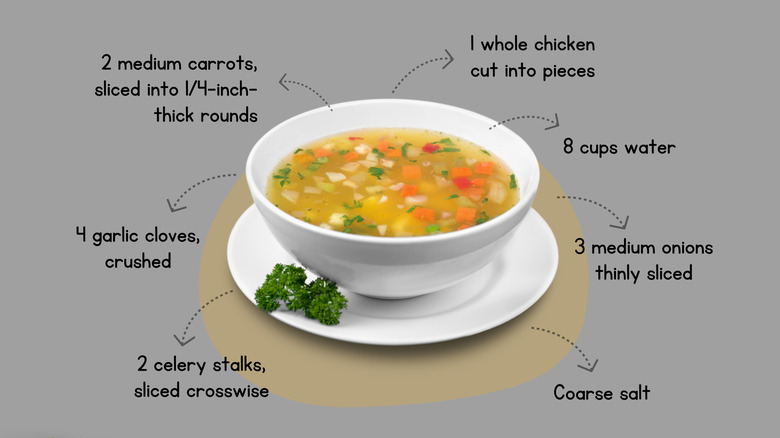Mistakes Everyone Makes When Cooking Chicken Noodle Soup
Chicken noodle soup has persisted as a classic comfort food for years, with many cultures touting its restorative and soothing properties. Even when we're perfectly healthy, chicken noodle soup carries a certain nostalgic simplicity in its rich yellow broth and pillowy noodles. It's delightfully cozy on cold nights or cloudy days, and just as enjoyable paired with a sandwich for a light lunch. While its handy canned counterpart may be readily available, nothing will ever surpass its homemade equivalent.
Recipes have evolved over the years, but the core components of this soup remain the same. Yet, despite its enduring simplicity, there are still plenty of fumbles one can make when cooking up a batch of chicken noodle soup. From selecting the right ingredients to the order you should add them in, there are a few things to keep in mind before grabbing your favorite soup pot and donning your apron. Let's take a look at some of the mistakes people make when cooking this wonderful and timeless dish.
Overthinking the ingredients
One of the first missteps people often make with chicken noodle soup begins before they've even stepped foot in the kitchen. Instead, it happens while roving the aisles of the supermarket in search of the perfect ingredients, often overcomplicating the recipe. Chicken noodle soup should be simple. All you need is chicken, stock, noodles, some herbs and spices, and your preferred vegetables — usually carrots, celery, and onion — although feel free to add potatoes, peas, and corn as well.
No, you don't need to craft your own homemade egg noodles or spend hours simmering a bone broth for a flavorful soup. If you have the time, you can make your own chicken stock in just a few hours, but it isn't strictly necessary. Chicken stock is made by slowly cooking chicken bones along a mixture of vegetables and spices. For chicken stock, this often includes sliced carrots, onions, and celery (also known as a traditional mirepoix) along with spices like black peppercorns, thyme, and parsley.
Haven't got the time for brewing your own batch of chicken stock? Fret not. If you're in a pinch, you can always build chicken noodle soup from store-bought stock, which is usually less salty than broth, or even canned soup that you add aromatic herbs and vegetables to, along with plenty of water. Finally, when it comes to the noodles, the best bet is usually to opt for frozen egg noodles, which hold their shape better than dry egg noodles. They also tend to contain less preservatives than other options.
Not cooking the noodles separately
It's tempting to toss those noodles straight into your soup pot so they have plenty of time to soak up all those flavors, but this comes at a price. The noodles will cook much faster than your other ingredients, quickly becoming mushy. Save yourself from a soggy, noodly mess by boiling them separately. You can still cook them in chicken stock, just in a separate container toward the end of your soup's cooking time. Then, you can drain your perfectly-textured noodles at whatever stage they appeal most to you and place the desired amount in each bowl, finally covering with a serving of soup.
Additionally, if saving chicken noodle soup for later, consider storing the noodles separately to avoid them swelling and sponging up all the liquid overnight. The plan was to make chicken noodle soup after all, not just chicken with noodles. Doing this will allow you to recreate your ideal dish in subsequent reheatings, preserving the noodles' texture while maintaining the right ratio of liquid to solid.
Making a thin soup
For those who love heartier, thicker soups and stews, a common complaint of chicken noodle soup is that it can be too thin. However, this problem is easily prevented by starting your soup with a roux, made by heating a fat with flour. Although you can use many fats to make a roux including chicken fat and cooking oil, the most common ingredient you'll see used is butter. To craft a roux for soup, simply heat equal parts flour and butter until it achieves a smooth, paste-like consistency, then combine the heated roux incrementally with chilled chicken stock (or a chilled roux to warm stock), whisking or stirring until fully blended.
Still, a roux isn't the only way to thicken your chicken noodle soup. Adding beans to the pot can also increase the thickness, especially if you crush them. You may also cook potatoes and puree them, blending this into the soup. Lastly, if your soup seems too thin or watery, you can always reduce it by simmering it until more water evaporates. This is a great tried-and-true method if you don't have any other thickening agents available.
Under-seasoning the soup
Although it's tempting to assume the chicken and veggies will do all the flavoring in soup, herbs and spices are also needed to give a soup plenty of rich flavor. Not sure which spices to grab? Any of the herbs and spices that you find in poultry seasoning will pair well with chicken noodle soup, such as sage, thyme, rosemary, black pepper, and marjoram. Other great flavorings to consider include parsley and bay leaves.
If you'd like to get truly fancy, you craft a spice sachet or a bouquet garni. These bunches of herbs and spices can be contained in something like muslin or cheesecloth or simply wrapped in twine. You can fill these savory additions with any flavorings you like. Spice sachets can include odd-shaped items like cloves, whole leaves, and peppercorns, while tied bundles are better for just leaves and stems. Both are removed before serving.
Garlic is another spectacular means to add more flavor to your chicken noodle soup, be it in chopped cloves, in granulated form, or even powdered garlic. Crushed and minced garlic will imbue your soup with the most intense flavor, while powdered will produce a more mild seasoning. Granulated garlic will fall somewhere in between. Looking for a more pared-down spice blend? Our simple chicken noodle soup recipe uses two garlic cloves and a bay leaf.
Boiling the brew
Be sure to watch your stove top when making soup — you want to keep that cozy concoction at a simmer, not a boil. Unsure of the difference? When you boil liquids, you keep the temperature at 212 degrees F, but when you simmer them, it falls somewhere between 185 and 205 degrees F. The two also look very different. Boiling soup will display big, frequent bubbles, while simmering results in smaller, slower bubbles.
Simmering is better than boiling when it comes to soups because the process is gentler. Boiling soup on higher heats can lead to mushy vegetables and clouding, while simmering permits flavors to meld and items to cook more slowly. There is also less risk of burning the bottom of a soup when the mixture is simmered. When cooking any soup, be sure to lower the heat as needed to keep it at an even simmer and leave it uncovered. It will be easier to keep everything at a lower temperature if you leave the lid off.
Rushing the process
Given the convenience and quickness of canned soup, many are quick to forget that fashioning the homemade version is a process, not a race. Crafting a good chicken noodle soup takes time — you need to allow all those flavors to develop, letting the herbs, spices, and chicken impart their flavors to the soup. Always permit your chicken noodle soup simmer for at least an hour, preferably simmering for a few. Some dedicated cooks even recommend letting chicken noodle soup simmer away overnight or adding ice to slow the heating process even more, drawing out the flavors more gradually.
Another reason you should give your soup plenty of time to simmer? Reduction. When you let a soup simmer at low heat, some of the water will cook off and evaporate, leaving you with a richer, more concentrated flavor. It will also help prevent soups from becoming too thin or watery. Rushing the cooking process can leave you with a less flavorful soup, as it hasn't had time to reduce to the proper consistency.
Too enthusiastic with the salt
Be sure to watch how much salt you add to chicken noodle soup, especially if using store-bought broth, some of which can fall on the higher end of the sodium spectrum. Starting with a high sodium base, then adding more salt, coupled with reducing the soup, can result in a chicken noodle soup that's just too salty. Avoid the sodium overload by either choosing chicken stock, which is unseasoned and contains less salt, or opt for low sodium or reduced sodium chicken broth. A product labeled as low sodium should have 140 milligrams of sodium or less per individual serving. Meanwhile anything listed as lower sodium or reduced sodium should contain 25% less than that brand's regular item.
If you still end up with soup that is over-salted, don't toss it. There are a few remedies for this dilemma. The best is to add a starch-rich potato to the mix to help soak up the salt. Just peel the spud and gently place the potato into your soup, cooking it for at least 15 to 20 minutes. Next, fish out the potato and sample your soup. If it's still overly salty, consider adding more water or using some fresh parsley or basil to disguise the salty flavor.
Only using chicken breasts
White meat, like chicken breasts and chicken wings, may have a higher protein content, but the dark meat is where the fat and richness is. Although you can use chicken breast alone to make chicken noodle soup, you'll get a much richer, fully flavored soup if you add in dark meat. Are you removing the skin as well? Don't. Chicken skin is loaded with collagen, and when added to stock, lends it a silkier texture.
Another option is to use chicken with the bones still in. When the chicken begins to fall off the bone, you know your creation is nearing completion. It's now time to pull out the protein, remove the bones, and place the meat back in the soup. Just remember when using portions of the chicken with a higher fat content, you will want to skim the fat off the top as it forms. Although leaving it there won't alter the final flavors of your soup in any way, many find it to be a bit unsightly.
Skipping the acidity
It may sound strange, but adding a little acid, like lemon juice, vinegar, or dry white wine, helps to balance soup and boost the flavor. It really shouldn't be all that surprising considering how many recipes pair chicken with lemon, like our roasted chicken with lemon butter recipe. For lemon enthusiasts, feel free to add either lemon juice or lemon zest to your chicken noodle soup. The amount needed will vary by recipe, but as a general rule, begin by using half a lemon, upping the content as needed from there.
When you add an acid to a soup, you'll want to do so toward the end of the cooking time so you don't lose the bright, vibrant flavor. Don't have any lemons on hand? A splash of apple cider vinegar, sherry, or white wine will work as well. Even tomatoes have enough acidity to help balance ingredients. Balsamic vinegar, rice vinegar, and red wine vinegar are also viable options.
Being too rigid with the recipe
Ever begun your cherished recipe and midway through, realized you forgot to buy an integral ingredient? It happens to the best of us. That's okay — your dish won't completely fall apart if you need to modify it with a quick substitution. Go ahead and sub vegetable broth for chicken broth. It's likely no one will notice as the color and flavor profile are incredibly close to chicken broth and it usually contains many of the same aromatic ingredients.
Forget the potatoes? Swap the spuds for cauliflower or turnips. Cauliflower is a great potato substitute, often going undetected. Likewise, turnips have a potato-like texture, but with a more earthy flavor with sweet and peppery notes. Haven't got any egg noodles on hand? Don't despair. Consider adding a common pantry pasta like rotini or breaking spaghetti noodles in half. Get creative and try star-shaped stelline, ditalini, or orzo. You can also exchange something leafy in place of noodles, like cabbage, spinach, or kale. Substitutions can lead to innovations you never would have created otherwise.
Adding all the ingredients at the same time
Although it's tempting to plop everything in the pot at once and check back later, this isn't the best method. Order matters when cooking chicken noodle soup. If you add all your ingredients at once, the quick-cooking items will over-soften before longer cooking ones are done. You could end up with soggy noodles or mushy vegetables, detracting from the finished product.
You should always begin with the aromatics, as these are your flavor base, sautéing your carrots, onions, and celery for a few minutes. Browning your vegetables instead of adding them straight to the liquid is an essential step. It will help the sugar in the carrots and onions to caramelize, enhancing their flavors. Next, many add the chicken to the pan to brown it, followed by your longer cooking vegetables like potatoes, parsnips, or turnips. You can then add any spices right before you pour in the stock or broth. Bring the soup to a boil before you lower the heat.
Once the soup is simmering, add your herb bundles or a simple bay leaf. As your soup slowly bubbles away, continue tasting the medley, adding salt and pepper as needed. Add pre-cooked ingredients, like pasta or noodles, in the last few minutes, or simply ladle the soup atop them. Remember to save any acids or quick-cooking items like spinach and kale for last so you don't lose their flavor.
Being afraid to experiment
Think you need to preserve the revered family recipe, keeping it unchanged forever? You don't. While many people swear by "old-world" recipes, the fact is these dishes came from a different era. Certain resources were scarce, and many soup recipes aimed to utilize culinary items that would otherwise be thrown out, like chicken feet or a previously cooked carcass. By all means, bring your great grandmother's hallowed chicken noodle soup recipe into the modern era by adding a ½ cup of vodka, or imbuing it with your own loving additions.
Integrating seasonal touches or cultural ingredients is a great way to personalize a soup and truly make the recipe a signature dish. Consider adding elements like turmeric for a rich hue, soy sauce or miso to up the umami flavor, sriracha or cayenne for some spicy heat, or ginger to give your chicken noodle soup a distinguishing twist. Feel free to incorporate seasonal items into the dish as well, like winter squash or summer tomatoes. Corn, peppers, and sweet potatoes are all also interesting ingredients to play with. You never know what delicious creation you might invent along the way once you free yourself up to experiment.
Not making enough
Many agree: Soup tastes better the next day. It's not that it wasn't great the night before, but for some reason it just seems to have something different about it after being chilled. Why is this? Not only do you have sensory fatigue right after making soup, but flavors continue to develop while it rests. When soups are stored at cool temperatures, certain flavor compounds slowly move from places of more concentration to places of less concentration. The flavors disperse from one item to another, rounding out the taste into a more rich medley.
Given this, you're definitely going to wish you had more to savor the next day. Yes, a leftover bowl or two is nice, but three or four is better. If you're going to go through all the hard work of crafting the perfect soup, its best you make enough of it, whether it be to share or simply to squander all to yourself.

